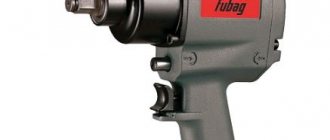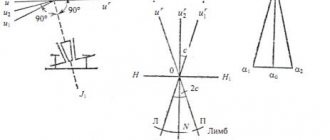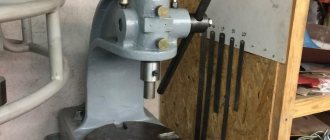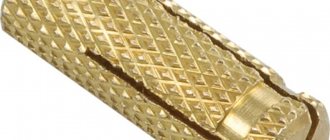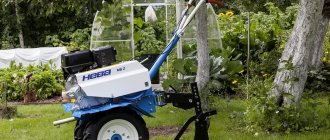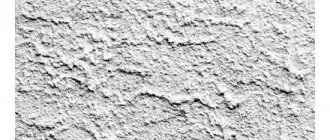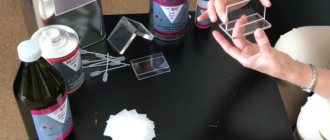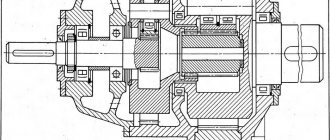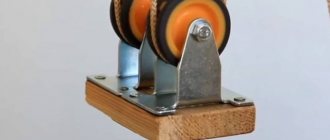Working principle of round baler
Before the formation of the next bale begins, the wire, the ends of which are fixed in knife-clamps, bends around the guide fingers and passes through the bale chamber and needle rollers to the cassettes. With each working stroke of the piston, the amount of hay in the bale chamber increases. It puts pressure on the previously formed and tied bale, pushing it towards the exit. The wire, pulled out from the cassettes, covers the bale on three sides. During the reverse strokes of the piston, the compressed mass is kept in a compressed state by the teeth of the groovers.
When moving in the bale chamber, the mass of hay turns the measuring wheel, which, after making one revolution, the fingers act on the lever to engage the clutch of the drive of the knitting machine. As soon as the stop protrusion located on the inner surface of the leading part of the clutch approaches the pawl roller, the crank shaft begins to rotate. The needles move from the lower position into the pressing chamber. Having passed through the windows in the bale chamber and the grooves of the piston, they lay the wire on the knitting hooks and in the grooves of the clamp knives and thereby cover the bale with the wire on the sides of the piston. The baler's tie hooks rotate to grab both ends of the wire. The wire, laid with needles in the grooves of the clamps, is clamped and cut. In this case, the ends of the wire, the branches of which go to the needles, are clamped, and the ends of the branches covering the bale are free. Rotating knitting hooks twist them into knots. The needles return and the safety hooks retract the wire connected to them, preventing it from getting caught on the knitting hooks. After the knitting hooks make two turns and the safety hooks return to their original position, the knitting machine drive is turned off. The wire twisted into knots is pulled from the knitting hooks by a bale that advances during subsequent working strokes of the piston. The bales are tied with twine using twine-tying machines installed instead of wire-tying machines. The main element of these mechanisms is the knotter, consisting of:
- clamp
- beak
- knife
The clamp consists of two disks compressed by a spring. The beak consists of a fixed lower jaw and a movable upper jaw. The movement of the movable jaw occurs due to the rolling of a roller attached to its second end along guide tracks. During the period of tying the bale with twine, the beak rotates 360º. While the upper jaw is lowered, both strands of twine covering the bale lie on it. As the beak turns, the twine is wrapped around the jaws, forming a loop. When the upper jaw rises, both threads enter the opened pharynx. After the beak closes and firmly clamps the threads, the knife cuts them behind the resulting loop. In this case, the end of the thread passing through the eye of the needle is pinched with a clamp. When moving the bale, the ends of the twine, clamped by the beak, pass through the loop, forming a knot. The moving bale pulls and tightens the knot. This is interesting: The design and technical characteristics of the Kyrgyzstan baler - we describe in detail
The pick-up is a two-shaft belt conveyor supported on the soil by two measuring vane wheels. These wheels are mounted on sidewall brackets, which are pivotally connected to the supporting platform independently of each other. This allows you to copy the field surface with the front shaft of the pick-up in the longitudinal and transverse direction.
The platform is rigidly connected to the inclined body and can rise and fall with it under the influence of hydraulic cylinders. At the same time, it rotates around the axis of the suspension on the thresher.
The drive shaft is mounted on bearings, the housings of which are rigidly connected to the sidewalls of the platform. The guide roller rotates in bearings installed in the sidewalls. The latter rest on ball bearings placed on the drive shaft and can independently rotate relative to the axis of the drive shaft when following the field topography with support wheels.
The sidewalls are hingedly connected by a tubular cross member and a normalizer pipe. Thanks to this scheme, the pick-up, resting on the soil with its wheels, can copy the unevenness of the field topography in the longitudinal and transverse directions when the combine moves. The installation height of the picking fingers in relation to the field surface, depending on the state of the rolls being picked up and the field topography, is adjusted by rearranging the spacer bushings on both sides of the brackets. The axles of the weathervane forks of the support wheels are attached to the brackets.
Rice. 1. Kinematic diagram of attaching the pick-up platform to the threshing machine: 1 - platform; 2 — inclined body; 3 - thresher; 4 — hydraulic cylinder for raising and lowering the platform; 5 and 18 — springs of unloading devices; 6 and 17 - unloading devices; 7 — left side of the pick-up; 8 and 15 — support wheels; 9 and 16 — spacer bushings; 10 — normalizer; 11 — tubular cross member; 12 — drive shaft; 13 — guide roller; 14 — right side of the pick-up
The angle of attack of the working branch of the picking conveyor in relation to the roller is changed by raising and lowering the platform.
The speed mode of the action of the spring fingers on the selected grain mass is regulated by a stepless V-belt variator of the conveyor drive.
The technological process of the pick-up platform (Fig. 2) proceeds as follows. When the combine moves, the windrow is directed to the middle part of the pick-up. The spring rakes of the conveyor belt comb the stubble from below. They lift the grain mass concentrated in the windrow and under the roll onto a conveyor belt. The normalizer presses the supplied grain mass to the top of the conveyor and, with some support, directs the mass flow into the platform auger.
Rice. 2. Process diagram: 1 - rake; 2 - belt conveyor; 3 - normalizer; 4 - drive shaft; 5 - active stem-puller; b - sloping board of the stem puller; 7 - auger; 8 — platform frame; 9 - beater; 10 — spacer
At the moment of a sharp turn, when the belt bends around the upper drive shaft, the rakes are freed from the main mass and, when interacting with the edge of the active stem puller, they are completely cleared of the plants remaining on them. The sloped board of the stem stripper, making oscillatory movements at the speed of rotation of the conveyor drive shaft, feeds the removed stems and crumbled grains into the auger. The latter, with spirals in the right and left directions, moves the roll to the window in the center of the platform. Next, the finger mechanism of the auger captures it and delivers it to the beater, from where the mass, under the influence of the floating feeder conveyor, is fed into the thresher.
The design of the pick-up for Don combines has been improved. It differs from domestic and foreign samples. For example, chains are installed along the edges of the pick-up belt for significant distortions of the drive and driven shafts when transversely copying the field surface.
The quick release spring pins are abrasion resistant. The active stem puller oscillates with the speed of the drive shaft. To attach the pick-up to the platform, a special device is used without additional loading equipment.
Roll presses
- One of the main advantages of the device is the duration of the cycle. It is easy to use and easy to maintain. Repair work is also easier to carry out compared to bale units.
- A significant drawback is that the cylindrical nature of the bales makes them larger. As a result, some difficulties may arise during loading and unloading operations, because additional mechanisms will have to be used, which will lead to increased financial costs. Additional resources will also be needed: materials, raw materials, human labor.
Varieties
How do balers work? The design is based on a pressing chamber. Here the plant mass is compressed, formed into windrows of a certain shape and covered with wire or twine.
The result is a compact roll of hay, which is convenient for transportation and further storage.
Please note that balers are available in several versions. All models on the market belong to the category of trailed equipment; accordingly, the force required for operation is transmitted through the power take-off shaft of the tractor.
Taking into account the features, the equipment can be divided into two groups: large-sized equipment and a mini baler.
- The first group is used on an industrial scale;
- The second one works with walk-behind tractors and tractors of small and medium traction class.
It is worth noting that using high-performance attachments that are combined with heavy tractors in small areas is unprofitable.
In addition to performance parameters, the technology differs in the way the plant mass is processed. Based on their operating principle, balers are classified into 2 types.
Which one is better to choose?
When choosing a baler, it is necessary to take into account the size of the area being processed and the volume of work. If you plan to produce up to 1000 packages in one season, then an inexpensive machine, without additional body kits, or a mini-press will do. To produce 5,000 packages, it is recommended to choose a mid-class unit.
The best low-cost balers are Claas Rollant 44, Claas Rollant 66 and Claas Rollant 250.
These devices are equipped with reliable rollers made of sheet steel. They are easy to operate, knit with twine or a net, and are comfortable to use both in small and large areas.
Chinese
Among Chinese devices, it is recommended to consider an option such as a baler from Dingxin. Its weight is 490 kg, and its productivity is 3-4 tons of finished product per hour. The device wraps the roll in 2-6 layers. Dimensions: 3.5*1.5*1.4. The final weight of the finished roll can be adjusted in the range from 15 to 80 kg.
Another good and reliable unit is Neweek. The manufacturer gives it a warranty of more than a year. The weight of the device does not exceed 390 kg, the operating speed of the pick-up is 2-5 km/h, the tire size is 16*6.50-8-4RP. It is easy to transport. This device is used when processing small areas. The size of the resulting roll is 0.5*0.7 m.
Polish
Among Polish-made devices, it is recommended to choose a baler from Simpa. Dimensional parameters of the equipment - 4.85 * 2.5 * 1.55 m, total weight - 1510 kg, operating speed - 7 km/h, maximum transport speed - 15 km/h.
This device is suitable for processing large areas. Maximum output is 3,500 rolls per eight-hour shift. The power of the power unit is 38 horsepower, and the power consumption of electrical equipment is 25.5 kW.
Such a roll picker can work with any vehicle model with a minimum towing class of 0.9 and engine power of 38 horsepower.
Another
Among Russian-made models, SpeedWay 120 is a good option. Such equipment is used for processing large areas. The total weight of the product is 2200 kg, the width of the film used is 0.75 m, the highest transport speed is 10 km/h.
In 1 hour of operation, the equipment produces up to 60 rolls. Dimensional parameters of the finished product: 1.55*1.2 m.
The device is designed for high-speed packaging of grass, hay and straw in rolls in specialized film. There is a carriage equipped with a mechanism for tight winding, and an internal combustion engine equipped with an electric starter ensures autonomous operation of the packer.
Square Baler
Here the design is based on a press, which, with reciprocating movements, forms the plant mass into rectangular briquettes. One of the advantages of this type of equipment is the ability to adjust the bale density.
In addition, foreign objects that enter the working chamber of the baler are removed using a special pulley. This allows you to minimize the likelihood of mechanical damage to the equipment.
The efficiency of the baler directly depends on the moisture content of the plant mass. Recommended humidity parameters are 25-26%, so it is better to carry out feed preparation work in the morning or evening.
Separately, it is worth highlighting the baler for the mini-tractor. This is a fairly compact equipment that works effectively in small areas. Here you can also find roll and bale modifications, but the resulting rolls will be much smaller. For example, a bale baler will form hay into briquettes weighing about 20 kilograms. Such bales can be loaded manually without using additional equipment.
What to choose
The following types are currently produced:
- square baler;
- baling machine.
The bale machine is equipped with a device for receiving hay, a pressing and knitting mechanism, and an adjustment device. The baling process is carried out as follows: the teeth pick up the windrow and transport it using an auger to the bale chamber. When the feed pressure reaches the limit, the tying machine is turned on, and after tying, the bale is thrown to the ground.
When choosing square pickers, pay attention to the following characteristics:
- the ability to adjust the bale density and size;
- the ability to work on an area with an uneven surface;
- mechanism power;
- working width;
- throughput;
- speed of work;
- reliability of design;
- ease of maintenance and repair.
The main choice is made depending on the performance of the equipment. A unit that is too powerful will take a long time to pay for itself and remain idle; a weak one will not be able to process the required area in a short time.
German models
The German Welger bale picker is used for baling hay and straw. The design works in conjunction with a low-power tractor of only 35 hp. The productivity of the unit is 7 t/hour. Straw pressing is carried out in a working chamber, which has dimensions of 36x48 cm. The adjustment system makes it possible to choose the length of a hay bale from 30 to 130 cm. The prices for such models are quite high.
Polish models
The Polish model of the Simpa pick-up has been produced for over 30 years. The quality of work of this unit is high. The Simpa RK4000 model is equipped with a hydraulic system for lifting straw from the ground. The design allows for the installation of skids for transporting finished bales to a trailer.
Specifications:
- Dimensions of the press: 4.85 x 2.5 x 1.6 m.
- Weight 1.6 t.
- The dimensions of the working chamber are 40x60 cm.
- Bale length 30-135 cm.
- Capacity 25 t/hour.
Baler adjustment
The position of the needles relative to the pressing chamber and the clamp grooves is adjusted by changing the thrust of the needle drive mechanism.
In the initial position, the gap between the needle tips and the camera is set to 20 mm. In this case, in the uppermost position, the roller axes will extend beyond the plane of the clamps by 65-75 mm.
The movement of the needles and the piston must be coordinated so that at the moment the needles enter the chamber, the ribs of the piston slots pass the place where the needles enter the chamber by 10-20 mm.
When moving, the needles should pass through the centers of the slots of the bale chamber and over the centers of the grooves of the jaws of the clamps, and the distance of the needle rollers to the ridges of the clamps should not exceed 2 mm.
The ridges of the clamps in their extreme positions should not overlap the groove by more than 1 mm. To prevent hay from packing between the piston angles and the guides, the gap between them should be no more than 0.8 mm. The compaction density is adjusted by a screw device.
Disassembly, assembly and installation of the pick-up on the combine header
Disassemble the drum type pick-up:
- Loosen the mounting bolts and remove the left and right side panels And || support shoes 9 (see Fig. 16).
- Unscrew the bolts securing the ramps and remove the ramps 12.
- Unscrew the nuts on the bolts securing the cover of the right bearing of the central shaft to the housing, remove the cover and release | face of the bearing mounting on a split conical bushing.
- Unscrew the nuts on the bolts securing the right and left pick-up beams to the frame pipe, remove the right beam together with the bearing housing and remove the frame.
- Unscrew the set screw 6 securing the hub 5 of the coupling to the shaft, remove the hub and key (see Fig. 17).
- Unscrew the nuts 9 on the bolts securing the casing 7 to the beam and remove the casing from the shaft.
- Unscrew bolts 2 securing the beam with flange to the hub be-| this track, unscrew and unscrew nut 8 securing the hub to the shaft and remove the beam together with the flange.
- Unscrew the filler plug in the housing 14, drain and add oil, remove the bolts 17 securing the housing to the support disk 18 and remove the housing together with the sealing gasket.
- Remove the thrust sleeve 13, the sealing ring 12 and the hub with the treadmill from the shaft.
- Remove the cotter pins, unscrew the nuts on the crank mounting bolts 3 at the ends of the rake pipes, remove the cranks in-| and> with dowels. Remove spacer sleeve 26 and support disk 18 from the shaft.
- Unscrew the bolts securing the half-bearing caps | 1 the front and right supports of the rake pipes, unscrew the bolts, remove the covers along with the upper half-bearings. Remove the rake pipes.
- Measure the distance between the axes of symmetry of the holes irsh'shsy 23 and the middle 22 of the supports and from the end of the shaft to the axis of symmetry from - | fpi'inii extreme support. The distance between the axes of symmetry: the outer and middle supports should be 1216±3.5 mm and from the ends to the axis of symmetry of the holes of the outer support 100±2 mm. Remove the outer and middle supports.
Checking the pick-up parts and assembling it:
- Inspect the condition of the sealing cuffs 19 (see Fig. 17) and g. I.I 24 and the support disk 18, check the cuffs 27 in the housing 14, in the treadmill hub 15, in the housing and cover of the right bearing of the central shaft 1.
- Check the fastening of the spring fingers of the rake to the crowns and 'Gitm rough, their condition and position relative to each other. The ends of the rake must be in the same plane, the permissible deviation between two adjacent fingers of the rake is no more than 10 mm.
Assemble the picker:
- Place support 22 on central shaft 1 (see Fig. 17), install a key, put on support 23 and secure with bolts, maintaining dimensions of 100±2 mm from the end of the shaft to the axis of symmetry of the hole of the outer support and 1216±3.5 mm between the axes of symmetry support holes.
- Install the rake 20 into the pipe bearings. Place the bearing caps on the upper half-bearings 21, secure them with bolts, and secure them with wire.
- Place washers 25 on the rake pipes, install support disk 18 on the central shaft on the key, inserting the ends of the rake pipes into its holes, install cranks with rollers and secure them with bolts so that the rollers are located in the treadmill along the path behind the pipes.
- Place spacer sleeve 26, treadmill 15, housing 14 with gasket on the central shaft and secure it with bolts 17.
- Place sealing ring 12, bushing 13, lock washer on the central shaft and secure with nut 8.
- Install support beam 11 and flange 10 on the treadmill hub and secure them with bolts 2.
- Install hub 5 on the end of the central shaft on the key, secure it with setscrew 6. Install protective casing 7 and secure with nuts 9. Fill the cavity of the treadmill with summer transmission oil to the level of the inspection hole in the housing.
- Attach the pick-up frame to the left beam, put the right beam with the bearing housing on the shaft, attach it to the frame with bolts, secure the right bearing to the central shaft by tightening the nut on the split cone bushing. Install the thrust ring into the bearing cap, insert the bolts and tighten the nuts.
- Install ramps 12 (see Fig. 16) and secure them with bolts.
- Install the left and right side panels 11 and support shoes 9 and secure them with bolts.
- Turn the picking mechanism by the shaft and check the quality of its assembly. Touching the rake arms on the ramps and the rake mounting bolts on the inner surface of the ramps is not allowed.
Install the pick-up onto the header:
- Remove the safety shield 5 (see Fig. 16) and the reel drive chain.
- Release the fastening, remove the reel from the supports and secure the rods of the reel moving mechanism on the supports with wire.
- Remove the sprocket from the upper pulley of the reel speed variator and install pulley 1 in its place.
- Remove the cheeks connecting the heads of the knife and the rocker arm, and move the knife to the right so that the rocker arm does not touch the head of the knife.
- Move the middle figured visors 7 of the header bottom to the side (towards the middle of the header) and secure them in this position.
- Remove the bolts that plug the threaded holes on the bottom of the header.
- Attach tension pulley 2 to the bracket of the left side of the header. Place a flat washer under the bolt head and a spring washer under the nut.
- Unscrew the bolt of the fourteenth section of fingers (on the left along the path) on a header with a working width of 4.1 m and from the sixteenth section on a header with a working width of 5 m.
- Remove the removable reflectors 15, attached to the wind sheet of the header, and the auger spiral extensions 13 along with the brackets.
- Set the header shoes to a cutting height of 130 mm for harvesting normal windrows and 100 mm for harvesting thin or sagging windrows in stubble.
- Secure rubberized disk 3 (Fig. 18) to the hub of the central shaft with three bolts with spring washers, placing flat washers under the head of the bolts.
- Install the pick-up on the bottom of the header and secure it with four bolts, screw the middle support on the pick-up frame to the finger bar.
- Press hub 2 onto drive shaft 1 (see Fig. 18) flush with the end of the shaft and secure it with a locking screw. Place the protective casing on the shaft, insert the free end of the shaft into the hole in the side of the header and attach hub 2 of the drive shaft to the rubberized disk with 3 bolts. Move the drive shaft housing to the right and secure it to disk 5 with bolt 4.
- Place bracket 4 (Fig. 19) with support bearing 5 on the drive shaft, attach the bracket to the base and to the upper flange of the header sidewall and secure the bearing to the shaft with nut 1. Check the alignment of the pick-up shaft with the drive shaft and, if necessary, install washers between the bottom of the header and pick-up support beams.
- Place bracket 3 on the shaft and attach it to the bracket with 4 bolts.
- Install pulley 2 on the drive shaft so that the distance between the middle of the groove and the side of the header is 208 mm, and secure it with a wedge key.
- Place V-belt 3 (see Fig. 16) on the pulleys with the driven branch outward and tighten the belt with pulley 2.
- Install protective shields 6 on the fingers of the cutting device, safety shield 5 and secure it with a quick-release cotter pin on the reel beam axle and bolts on the bracket (see Fig. 16).
- Rotate the drive pulley of the pick-up drive mechanism, make sure that the pick-up drum rotates easily and that the components and parts are securely fastened.
Baler PRF 145
This modification has virtually no design flaws and has a high safety margin. The technical indicators of this equipment look like this.
Specifications:
- Structural weight 1,900 kg.
- Dimensions: length/width/height 4,150/2,300/2,400 mm.
- Covered area 1.45 m.
- Roll diameter 145 cm.
- Bale weight: hay/straw 375/250 kg.
- Speed indicators are 6-12 km/h.
- Productivity 5.5 tons/hour.
Baler PRF 180
This is a round baler with a closed working chamber. This design of the equipment allows us to minimize plant mass loss and forms rolls with a dense top layer and a loose middle. As a result, air freely penetrates inside the roll, preventing the formation of mold. The unit is based on a pressing mechanism, which is made in the form of a chain conveyor that continuously twists and compacts the plant mass.
The weight of the trailed equipment is 2,400 kilograms, which allows the baler to be mounted with tractors of 1.4-2 traction class.
Presentation on the topic “pickers” presentation for the lesson
Slide 1
Pickers
Slide 2
Purpose Purpose: The baler is used in the production of haylage and silage to select windrows of hay and straw for subsequent pressing with simultaneous wrapping with twine. Thanks to round balers, it becomes possible to carry out compact transportation and further storage of silage and haylage. Also important are such features of these balers as high productivity, reliability, energy savings and ease of operation.
Slide 3
Purpose Balers are intended for picking up windrows of natural and seeded grass and straw hay and then pressing them into bales or rolls while simultaneously wrapping them with twine. Balers enable compact transportation and subsequent storage of haylage and silage. Based on the method of compacting haylage and silage, balers are divided into two types: round and square.
Slide 4
Classification of round balers By type of bale chamber: - with a constant bale chamber; — with a variable pressing chamber. By type of pressing element: - with belt conveyor; — with a slatted conveyor; - with rollers. Baler with a constant roller bale chamber In this type of baler, the bale chamber does not change its volume, so the core of the bale turns out to be loose and under-pressed. At the beginning of pressing, the chamber is half empty and the roll is not pressed by the upper rollers. Baler with a constant conveyor bale chamber In this type of baler, the bale chamber does not change its volume, so the core of the bale turns out to be loose and under-pressed. At the beginning of pressing, the chamber is half empty and the roll is not pressed by the upper conveyor. Baler with a variable conveyor bale chamber.
Slide 5
Baler with a variable conveyor bale chamber. With this type of baler, the bale chamber increases in volume as it fills. The roll is obtained with almost the same density due to constant contact between the pressing elements and the roll. Such a baler consists of a pick-up (1), a pressing drum (2), a lower conveyor (3), a working loop (4), an upper tension roller with a loop (5), a rear valve (6) and a knitting device (not shown in the figure). shown), as well as the frame, support wheels, towbar and drive mechanism Composition: pressing belt tensioner movable roller drum conveyor
Slide 7
Baler with a variable roller baling chamber In this type of baler, hay is constantly compressed by pressing the bale with several upper rollers, which are initially at the bottom and rise up as the bale increases. The variable roller baler consists of a pick-up; pressing chamber; rollers located around the perimeter of the pressing chamber; rear valve; knitting machine (not shown in the figure), as well as the frame, support wheels, towbar and drive mechanism.
Slide 8
Device: Main elements: Conveyor-device with a standard grip of 1.7 m, or a wide grip of 2 m. Frequent rods that provide constant pressure over the entire surface of the roll. A rotor that facilitates the entry of product into the antechamber without slowing down or overflowing. Variable track, which ensures quality work on difficult soils and hilly terrain. Pressure rod to ensure bale density according to the type of product being processed. Mechanical hooks that close the rear hatch and allow the creation of heavy rolls. An electrical signaling device in the tractor cab that signals when the chamber is full. Traction handlebar, with the help of which the height from the ground to the frame of the machine is adjusted to adapt to a specific traction device.
Slide 9
The principle of operation of the round baler PRF During the forward movement of the baler, in conjunction with a tractor, the masses from the roll are picked up by the spring teeth of the pick-up and fed into the bale chamber, in which the lower rollers and rolling pins of the pressing mechanism twist this mass into a roll. The pressing grid performs preliminary compaction of the pressed mass. When the roll reaches the specified compaction density, a signal is given to the operator to feed the twine. After wrapping the roll with twine, using hydraulic cylinders, the bale chamber is opened and, due to the rotation of the lower rollers, the roll is unloaded onto the ground, and after closing the bale chamber, the process is repeated.
Slide 10
AMT baler. CORSA Transportation and storage: AMT.CORSA balers are not suitable for driving on public roads. If there is a need to transport them, it is carried out by road. AMT.CORSA balers are stored in covered premises to protect them from atmospheric influences to avoid corrosion.
Slide 11
The principle of operation of the pick-up stacker When the tractor moves, the pick-up collects the windrows and transfers them to the conveyor. Then the hay enters the chamber, where it is rotated using a rotating bottom and rollers and thereby compacted. When the chamber is full, the sensor is triggered, the back wall of the chamber opens, and the formed hay is automatically unloaded. Then the process repeats again. The operation of the pick-up stacker is carried out using a hydraulic system.
Slide 12
Structure of a square baler Composition: receiving device pressing part knitting device mechanism for transmitting movement and adjustment Stages of work: Selection Pressing Unloading bales
How to make a baler with your own hands
Balers are presented on the market in a fairly wide range, so farmers can easily select the appropriate equipment, taking the power of the tractor as a basis. However, ordinary summer residents, who only have a walk-behind tractor in their arsenal, find themselves in a difficult situation. It is quite difficult to find a baler for a walk-behind tractor, given that the bulk of summer residents are pensioners, it is difficult to imagine that they are ready to spend money on purchasing such a unit. Therefore, most home-grown craftsmen prefer to make such units with their own hands, since there are no complex elements in the design of the baler. Here is an approximate installation diagram:
- We manufacture the chassis. The best option would be to use a pair of pneumatic chassis.
- We install the front. Here are the fastening elements for all components, including the towbar for the walk-behind tractor.
- Assembling the bale chamber. In the lower part of the unit there are rollers, complemented by a pressure grid, in the upper part there is a spring block and a plate for pressing the compressed layers.
- We install the drive to operate the mechanisms. This is usually a two-speed gearbox with a chain drive for the rollers.
Please note that the diameter of the pick-up gears should differ to a larger extent from the roller gears. This will help increase the overall performance of the unit.
Presses for mini tractors
Equipment for mini tractors In recent years, a mini-baler has been increasingly used, which can be used in conjunction with walk-behind tractors or mini-tractors. Small dimensions allow you to work unhindered in small areas. Therefore, it is often used by individual farmers and private owners.
Mini presses also come in roll and bale types. The most important advantage is the formation of small bales, weighing no more than 20 kg. The compressed mass is easy to load and transport. Some models have an additional feature that allows you to adjust bale sizes or roll dimensions.
